Pernicously Proliferating Perilious Polymers I (and Pandora's Perplexing Presence)
09 Feb 2025 - VelikTzar
Words: Several. Time: Better spent someplace else
I have returned. I again lied last time, but I have a vaguely informative post to hold you over for the week. Do forgive me. I was again sincere. You know the drill, so I won’t explain myself much further. But I can’t leave the blog alone, lest the guilt eat me raw. I have done nothing all week, I have fallen behind in my research, but at least I remain committed to one thing - and thus everything will be alright. You’ve done well. Follows a talk which your friends had heard plenty of times. But the Reader could not have. You assume that they are not a complete moron and have a basic grasp of highschool level chemistry, that they’re not a worthless junkie, and that their plans consist of something more than smoking weed and masturbating, or whatever that chemistry teacher said. This is to be the first part of a two? part series of posts on fluoropolymers. Buckle up!
***
It was the year 1938, and a scientist in the employ of the Dupont Corporation, Roy J. Plunkett, stumbled upon a brand new compound - polytetrafluoroethylene (PTFE)(brand name - Teflon). And thus, the world was forever changed.
You see, Dupont were looking for a new refrigerant - the contemprorary refrigerants had the rather unfortunate tendency to leak. “Ice Machine leak - hundreds dead” - a New York Times headline at some point, probably. Even if I am exaggerating, your fridge killing you is, how do I put it, not a good look.
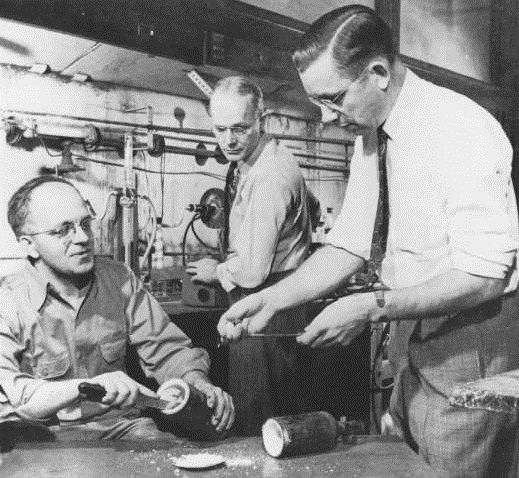
A re-enacment of the discovery of Teflon. DuPont Company External Affairs Department photograph file (Accession 2004.268), Audiovisual Collections and Digital Initiatives Department, Hagley Museum and Library, Wilmington, DE 19807
PTFE was very, very expensive to make. In fact, R. J. Plunkett may have said something along the lines of “What the fuck are we going to use that for?”. I can’t actually give you the source for that, because I can’t be bothered to find it. Can you imagine if such a discovery was just forgotten? In a different world, maybe.
Luckily for the Dupont Corporation, a certain World War happened soon after. Throughout this war, a certain project, named after a NYC borough, had a bit of a problem. There was no compound that could resist uranium hexafluoirde’s corrosion. If you’re planning on enriching uranium, that is a big problem to have. But we had discovered PTFE quite recently, and it turned out to be the perfect compound for the job. PTFE seals, valves and gaskets allowed the US to unleash the power of a thousand suns. And thus, the world was forever changed.

Thank you, PTFE, for letting us harness the power of a thousand suns!
The US Army Corps of Engineers had set up large scale production of this Teflon for that purpose. And why wouldn’t you? It, and later fluoropolymers, were, frankly, magnificent - chemically resistant to everything, really, great mechanical properties (e.g. tensile strength) (a lot of these a courtesy of its very large molecular weight - if a PTFE molecule was a train, where each TFE unit was a train car, the train’s length would be the length of the Trans-Siberian Railway. A rather big train), weather and impact resistant, extremely hydrophobic, and oil-repelling as well. Not to mention temperature resistant (-200 to +200 degrees Celsius, to give an example). Oxidation- and age-resistant. A miracle compound, if there ever was one.
A very big commercial breakthrough came later, with the discovery of the non-stick pan in 1954 (where the name of the Tefal company comes from - Teflon + Aluminum. Clever, right?). Teflon was here to stay, and for something more than just the nuclear industry. Soon it was joined by many, many friends. PVDF (polyvinylidene fluoride) was discovered soon after Teflon, and is now the second most widely used fluoropolymer.
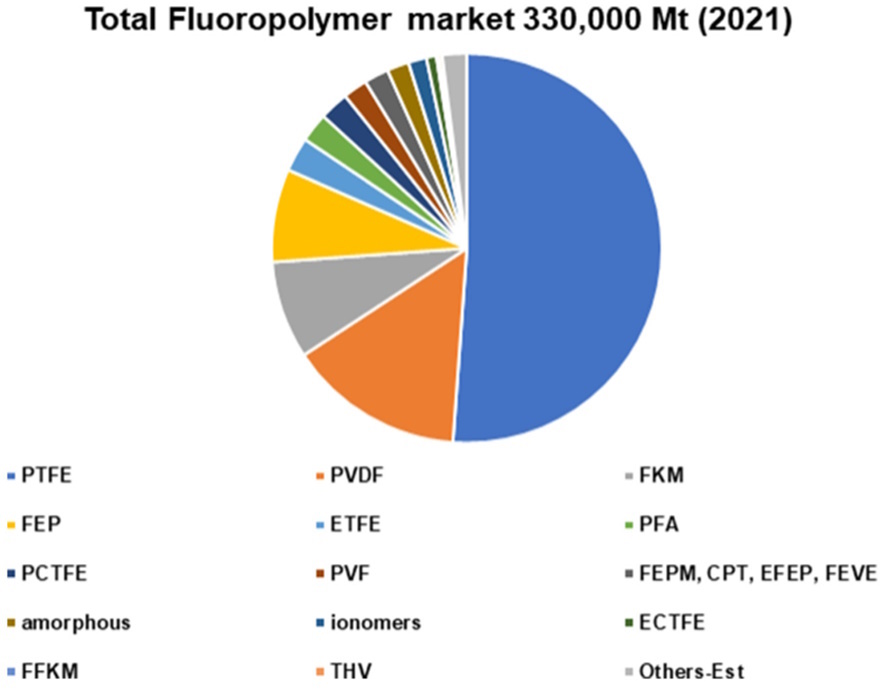
Teflon, the first child, still the pride of the family. Taken from Lohmann & Letcher, 2023
Now fluoropolymers are everywhere. They’re in the Lululemons you wear (see - that fat repellent bit, because the fluorocarbon chains have very weak van der Waals forces between them, thus very low surface energy, thus nothing sticks to them), as you rot away in your room all week, wasting the precious years of your youth (do dress better when you go outside. Or don’t, makes me feel better about myself). They’re in the raincoat of the Deliveroo driver who brings you your junk food, that you can’t be bothered to spend five minutes walking for (hydrophobicity - one of the most hydrophobic things we have.). They’re in the batteries of the phone in which cold blue light you bask, even as the sun’s life-giving light struggles to pierce closed curtains. They’re in the synthetic valve that is keeping your grandmother alive. They (may be) in the skincare and cosmetics you put on, at a failed attempt at self-care(many more pressing aspects of your lifestyle you could improve upon, don’t you think?) or just a straight-up vanity (I am vain, but aren’t we all?). They’re in the custom made O-ring seals of the wind turbines that (unlikely) give you electricity, or in the nuclear power plants, or, far more likely, in the pipes that suck the oil and gas that are burnt to give you said power.
They’re all around you.
Watch out, I am right beside you!
***
On classification
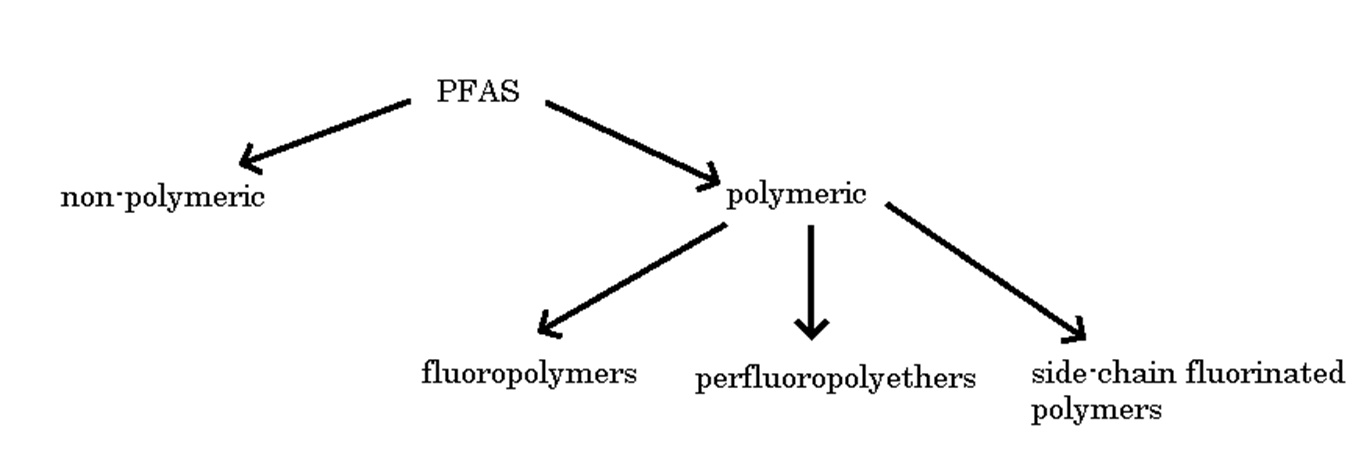
Classification of PFAS. Figure made by yours truly
What is a fluoropolymer? I don’t know. It’s a feeling. I can tell you they’re polymeric PFAS (per- and poly- fluoroalkyl substances). What is PFAS? Well. They’re organofluorine compounds, that’s for sure. But the exact definition will vary depending on where you live. In USA, they’re “A structure that contains the unit R‐CF 2‐CF(Rʹ)(R″), where R, Rʹ, and R″ do not equal “H” and the carbon–carbon bond is saturated (note: branching, heteroatoms, and cyclic structures are included)” (as per the USEPA). This definition might very well exclude PVDF (monomeric unit -CF2-CH2-), the second most common fluoropolymer. In the EU, the European Chemical Agency will tell you that it is any compound that has at least one fully fluorinated methylene or methyl group. A far broader definition. But, PFAS are what you feel PFAS are.
***
So good, so widely used. In fact, it is harder for me to find an area where fluoropolymers aren’t used in. And, despite my many jabs at you, the Reader, whose approval nevertheless I desperately crave, you may be thinking “Well, what a great group of chemical compounds, I’m grateful they exist, what’s not to love, great mechanical properties you say, perfect, very good, the best, even!”. I concur. They’re very good. But there is a chink in the proverbial armor of fluoropolymers (or, I suppose, a scratch on the proverbial non-stick pan would be more apt)
***
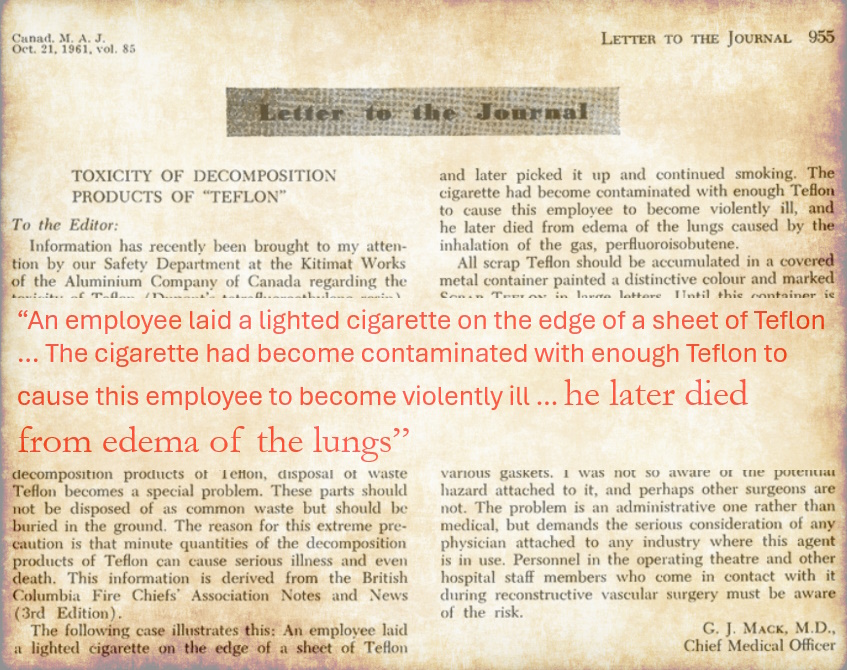 Trouble in Teflon Town. Text from G. Mack, Can Med Assoc J. , 1961, 85, 955–955
Trouble in Teflon Town. Text from G. Mack, Can Med Assoc J. , 1961, 85, 955–955
Now, this statement was later retracted. The death was blamed on the employee’s smoking habits. Smoking is bad (shocking!). I would know. The almost-permanent cough that accompanies me is a reminder of that. In the words of the author of the original case report:
“The Union Carbide Corporation, upon further investigation, and with the co-operation of du Pont, reported, in December of last year, there have been no deaths or permanent injuries known to stem from Teflon; all rumors of death are false.” (G. Mack, Can Med Assoc J., 1961, 85, 1358-1358)
Now, large corporations covering up a potential major health hazard to protect their bottom line sounds shocking, I know. I’m sure we can trust the kind people at Dupont and the Union Carbide Corporation. No bad news could possibly follow.
***
We’ll continue the story next week. And we’ll see if more bad news do follow, or if the original case report was alarmist hysteria. I’ll give you your references then. Can’t be bothered to organize them now. \
***
 Dante Gabriel Rossetti’s Pandora (1871)
Dante Gabriel Rossetti’s Pandora (1871)
This is a painting of Pandora by Rossetti. The model was his friend’s wife, Jane Morris. He fell in love with her, after being left alone in the house with her one summer (justifying all the ancient Greeks’ fears about leaving your wife in the company of other men). And who can resist using their friend’s beautiful wife as a muse. She was also the model of the Astarte Syriaca (1877), another of Rossetti’s paintings, that happens to be the site icon. If you’ve ever wondered why this waste of a website takes so long to load, maybe it’s because of the full-size site icon.
In any case, Pandora has been a favorite subject of painters. What’s not to love - and why won’t you take the excuse to have a beautiful woman model for you.
Here, Pandora holds her famous box, that infamously unleashed all the evils on the world. No doubt you’re foaming at the mouth, like an attack dog, wanting to tear her apart for literally ruining everything.
And if Pandora here was a metaphor for all the PFAS chemical manufacturers, with the risk of spoiling next week’s post, I’d agree with you. I mean, this paper (L. C. Hall, J. T. Wilson and J. G. Birnstingl, Remediation Journal, 2024, 34) literally calls PFAS “Pandora’s box”.
But she isn’t. She is just Pandora. And unlike the Union Carbide Corporation and Dupont, she did nothing wrong.
Our first version of the myth comes from the Beotian (We’ll speak of Thebes one day! I promise! Please don’t shout at me!) poet Hesiod. She is first mentioned (without the name) in his Theogony (for which I rely on the freely available online translation by Hugh G. Evelyn-White, 1914), and then mentioned by name, and her story elaborated further, in his Works and Days (of which I happen to have the 2018 Penguin translation on hand).
In the Theogony, Hesiod speaks thusly:
“[590]For from her is the race of women and female kind: of her is the deadly race and tribe of women who live amongst mortal men to their great trouble, no helpmeets in hateful poverty, but only in wealth.(…) [600] even so Zeus who thunders on high made women to be an evil to mortal men, with a nature to do evil.”
What a guy, huh! One would think he doesn’t have the greatest opinion of women! Though very interesting to note, in addition to the implication that women are a completely separate species from men, is how this role of Pandora, as a progenitor-woman, of sorts, is not something we think about. Perhaps this role in our minds has been usurped by Eve. Their stories are a bit similar, I suppose. Box, apple, who counts.
Going a bit off track, perhaps, but he also says this in Works and Days (373-375):
“Don’t let a woman mistify your mind
With sweet talk and the sway of her behind
She’s just after your barn. He who believes
A woman, is a man who trusts in thieves”
Certainly valuable advice for all men out there, though cannot compare to the part where he says you should not piss in a stream (W&D, line 757).
In short, the titan Prometheus (lit. “foresight”) tricked Zeus twice. First, on the matter of sacrifices - he had hid all the juicy meat beneath the belly of the animal, and in another pile were the bones, hidden beneath fat. Or so I remember. Zeus picked the seemingly more apetizing second pile, and thus the gods were condemned to forever receiving sacrifices of bone, and men could keep the good parts of the animal. You probably know the story better than I do. The other “trick” was straight up theft - when Prometheus stole fire from Zeus and gave it to men. And so, the king of the gods wanted to have his vengeance. In his words: “I’ll pay them back evil for fire; Evil in which they find their heart’s desire; They’ll greet their bane with open arms! “(W&D, 55-57)
Zeus ordered all the Gods to contribute in the making of Pandora, “the All-Gifted”. (It must be said, the fact that all the Gods contribute in the second version, and that she is given a name, make the second version of
Pandora more human, certainly, as opposed to the first one; and there the threat could be understood as to have come more from the creation of the “race of women” ;( ).
Hephaestus fashioned her out of clay, and she was given the face of a deathless goddess; given great skill at weaving by Athena (weaving being the thing for women to do), Aphrodite gave her “beauty and passion on her head”,
and Hermes gave her “a bitch’s mind” (as in, a female dog, not a compliment, I gather) and cunning.
She was then given as a gift to Epimetheus (“Hindsight”, the younger brother of Prometeus (the whole point of Works and Days is to berate Hesiod’s younger brother, so it tracks)), who had forgotten his brother’s warning
about not accepting gifts from Zeus.
Then poor Pandora removed the JAR! ‘s huge lid
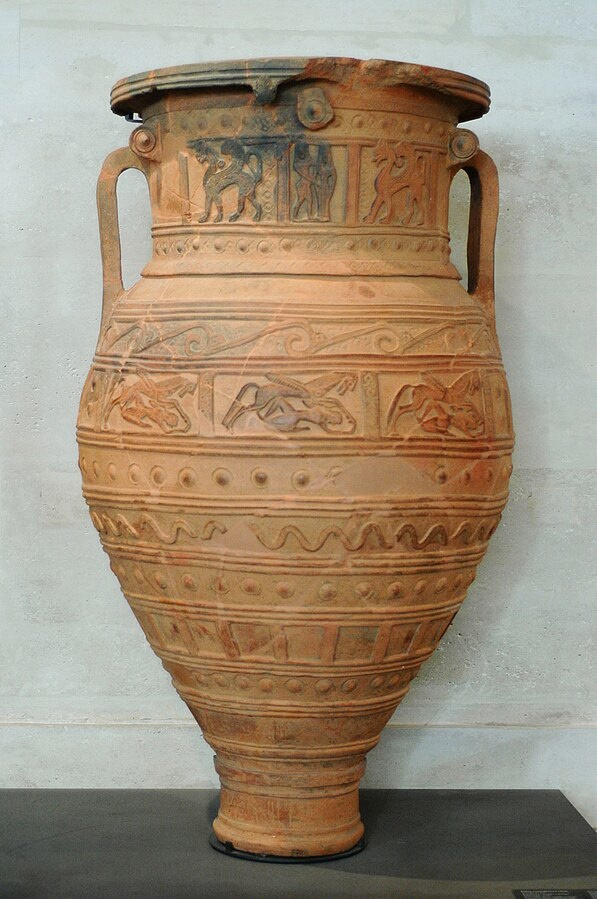 Pandora’s not-so-box; rather, a jar of the type Hesiod talks about, a so-called pithos, this one from iron-age Crete (yes, the first result that pops up and is in the public domain)
Pandora’s not-so-box; rather, a jar of the type Hesiod talks about, a so-called pithos, this one from iron-age Crete (yes, the first result that pops up and is in the public domain)
So, it a Pandora’s Jar, not a Pandora’s Box (there was a mistake in translation, and I suppose we like boxes more). The pithos that Hesiod would have talked about is very large, so the painting below (Nicolò dell’Abate’s Pandora(1555)) is not accurate in that way either, but it is better, and I like it.
 Pandora (1555)
Pandora (1555)
So it was. but it was not just every evil beneath the lip of the jar - the very need for work was there as well, for before the land would provide for men. So Zeus had his vengeance. As our Beotian poet tells us:
“So it is not possible to deceive or go beyond the will of Zeus: for not even the son of Iapetus, kindly Prometheus” in Theogony and
“No getting round it, Zeus’s schemes prevail” in Works and Days
Only Hope(Elpis) remained inside the jar. And we have debated whether it was a good thing ever since. Was Elpis itself good? It was literally in a jar full of evil.
But my point with telling you this is, that, well, Pandora’s whole existence was a ploy by the gods. How could she have resisted Zeus, cloud-herder, and the entire Pantheon, had she wanted to?
Zeus may want you to have to work for a living (oh, the pain of 9-5 wage-labor), but Pandora didn’t. It’d be like blaming the Companion bot for trying to kill you after its “owner” had programmed it to do so. (why yes,
I saw the hit movie Companion(2025) yesterday, starring the absolute icon Sophie Thatcher, and the absolute waste of flesh Huey from the BoysTM)
All of that could have been elaborated far, far better, but one - I am a STEM major, do not heckle me, and two, I nearly gouged my eye out (again) with my eyelash spiral, and my right eye hurts, so I must bid you goodbye.
***
I’ll see you next week! Have fun, and remember:
“Would I were not among the Fifth. I’m torn
Would I be better dead or not yet born?-
For this age is an Iron Age indeed -
Suffering never ceases for our breed”
(Hesiod, Works and Days, 173-176)